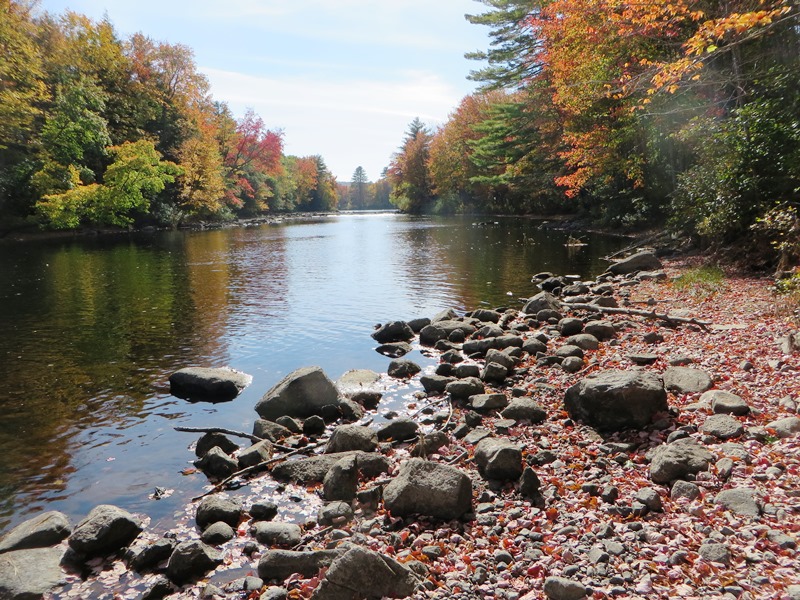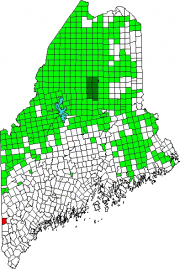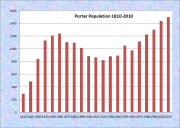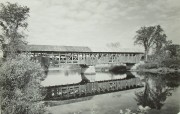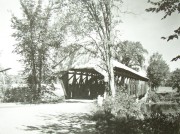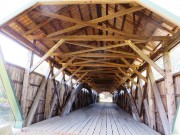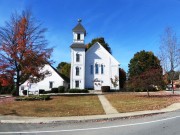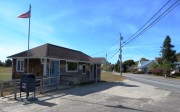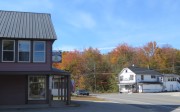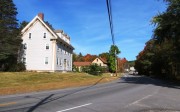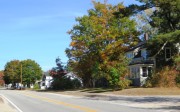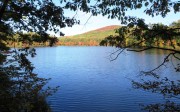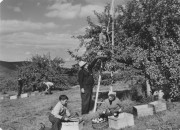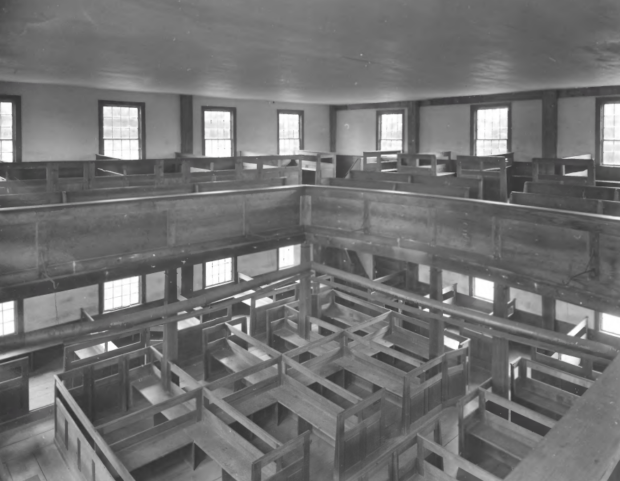| Year | Population |
|---|---|
| 1970 | 1,115 |
| 1980 | 1,222 |
| 1990 | 1,301 |
| 2000 | 1,438 |
| 2010 | 1,498 |
| Geographic Data | |
|---|---|
| N. Latitude | 43:49:49 |
| W. Longitude | 70:56:10 |
| Maine House | District 70 |
| Maine Senate | District 19 |
| Congress | District 2 |
| Area sq. mi. | (total) 32.9 |
| Area sq. mi. | (land) 31.5 |
| Population/sq.mi. | (land) 47.6 |
County: Oxford
Total=land+water; Land=land only |
|
[PORT-er] a town in Oxford County, incorporated on February 20, 1807 from Porterfield Plantation. It later set off land to Brownfield three times in 1831, 1832, and 1855. The township was purchased in 1795 by Dr.Aaron Porter and others.
Built in 1876, the two-span 152-foot covered bridge above crosses the Ossipee River on Maine Route 160.
The upper photos, circa 1950, are from the George French Collection of the Maine State Archives. The 2014 photos were taken in October.
The historic Old Meetinghouse was built in 1828 by a group of Baptist fundamentalists, known as Bullockites for their leader Jeremiah Bullock.
The Porter Union Church Society, organized in 1908, received the building, once the Advent Chapel, from East Freedom, New Hampshire. The “Union Workers” maintains the structure, with help from friends of the church.
In 1886 the town hosted seven sawmills, a grist mill, and several factories. In 1880 Porter’s population was 1,095 and it supported 13 schoolhouses.In the 21st century, most mills have been replaced by services, including a health food grocery store in the village.
Samuel Wadsworth Gould a U.S. Representative was born in here on January 1, 1852. He moved with his parents to Hiram and attended the public schools and North Parsonsfield Seminary.
The main village, Kezar Falls, shares its name with the other half of the community located across the Ossipee River in Parsonsfield, York County.
For a view of life in Porter in 1925, see its 1925 Town Warrant.
The town, which borders New Hampshire, is served by Maine Routes 160 and 25 (also known as the Ossipee Trail).
1950’s photos courtesy of Maine State Archives, George French Collection.
Form of Government: Town Meeting-Select Board.
Additional resources
George French Photo Collection, Maine State Archives, Augusta, Me. (black & white photos)
*Maine. Historic Preservation Commission. Augusta, Me. Text and photos from National Register of Historic Places: http://pdfhost.focus.nps.gov/docs/nrhp/text/xxxxxxxx.PDF and http://pdfhost.focus.nps.gov/docs/nrhp/photos/xxxxxxxx.PDF
Porter Old Meetinghouse: 73000267.PDF
Porter-Parsonsfield Bridge: 70000058.PDF
Moulton, Thomas. Porter, As a Portion of Maine: its Settlement, etc. Portland, Me. Hoyt, Fogg & Donham. 1879.
Pillsbury, Dora LePage. Katching up on Kezar Falls. Kezar Falls, Me. D. Pillsbury. 1992.
Teg, William. History of Porter. Kezar Falls, Me. Parsonfield-Porter Historical Society. c1957.
Wentworth, Carroll. Record, 1910-1911. (Cataloger Note: A volume used by Carroll Wentworth of Kezar Falls, Maine, to record his daily activities including weather observations, his farm chores and results from his egg business.) [University of Maine, Raymond H. Fogler Library, Special Collections]
National Register of Historic Places – Listings
Kezar Falls Circulating Library
The Kezar Falls Circulating Library is a two room Colonial Revival-style building in the village of Kezar Falls in the Town of Parsonsfield. John Calvin Stevens and John Howard Stevens Architects designed the building in 1923. A local subscription library association was formed in 1896 but was housed in small temporary quarters until the erection of this building. Local monetary, material and labor donations provided for the library building’s construction. The building is a significant Colonial Revival-style library design by John Calvin Stevens and John Howard Stevens Architects. The library retains its original exterior and interior design. A relatively minor alteration with limited impact was the replacing of a window with a door and adding a ramp for accessibility. It has a high degree of keeping original building materials, fine workmanship and design. The library is significant for the community of Kezar Falls.
Porter Old Meetinghouse
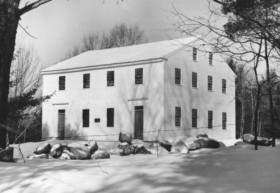 North of Porter village off Maine Route 25 (Old Meetinghouse Road)] The Porter Old Meeting House is a fine example of New England architecture of the early 19th century. It was built in 1818-1819, though it was not completed until 1824. The church was used by a sect called the “Bullockites” who were followers of Elder Jeremiah Bullock, a Baptist clergyman. It has also been used as a town meeting house. In the 1950s the Parsonsfield-Porter Historical Society of Kezar Falls took over the care of the building. At the time of the observance of the 125th anniversary of the Meeting House, the Parsonsfield-Porter Historical Society placed a bronze plaque on the front of the building which reads:* [O. B. Denison photos]
North of Porter village off Maine Route 25 (Old Meetinghouse Road)] The Porter Old Meeting House is a fine example of New England architecture of the early 19th century. It was built in 1818-1819, though it was not completed until 1824. The church was used by a sect called the “Bullockites” who were followers of Elder Jeremiah Bullock, a Baptist clergyman. It has also been used as a town meeting house. In the 1950s the Parsonsfield-Porter Historical Society of Kezar Falls took over the care of the building. At the time of the observance of the 125th anniversary of the Meeting House, the Parsonsfield-Porter Historical Society placed a bronze plaque on the front of the building which reads:* [O. B. Denison photos]
PORTER OLD MEETING HOUSE 1818 1953
To the Glory of God and In memory of our pioneer ancestors
Who erected this building.
Porter-Parsonsfield Bridge
[0.5 miles south of Porter village over the Ossipee River] The first bridge here was begun in 1798 and finished in 1800. A second was built in 1808 and was rebuilt in 1858, but a squabble erupted between the towns over the distance each town should be responsible for. Finally, Selectman Ivory Fenderson suggested a method of settling the question. The Porter Selectmen walked into the bridge from their side of the stream. The Parsonsfield town fathers walked in from their side. They met in approximately the middle and Fenderson took out his jack-knife, pitched it energetically into the plank at his feet and shouted, “the town of Parsonsfield shall build so far and no farther.”
The third bridge, the present one, at this site was built in 1876 each town sharing in the costs and so it was that two kinds of roofing bore witness to the fact that Parsonsfield and Porter shared repair costs equally until 1967 when the State Highway Commission (now the Department of Transportation) obtained title to the bridge, retired it and restored it. A new cover of cedar shingles was applied, thereby visually indicating the end of the old squabble.* [See photos above]


